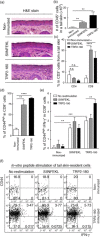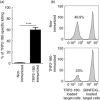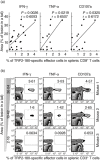Melanocyte-specific CD8+ T cells are associated with epidermal depigmentation in a novel mouse model of vitiligo
- PMID: 23711243
- PMCID: PMC3784211
- DOI: 10.1111/cei.12146
Melanocyte-specific CD8+ T cells are associated with epidermal depigmentation in a novel mouse model of vitiligo
Abstract
In the present study, we established a novel murine model of vitiligo by sequential prime/boost immunizations into the hind footpad and tail dermis with tyrosinase-related protein 2 (TRP2)-180 (SVYDFFVWL) peptide, lipopolysaccharides and cytosine-phosphate-guanosine (CpG) oligodeoxynucleotides. Immunized mice developed epidermal depigmentation in the tail skin without hair depigmentation, thereby differentiating this approach from established models of vitiligo. Following intradermal tail immunization, activated CD8(+) interferon (IFN)-γ(+) T cells were recruited locally to the tail skin. In-vivo cytotoxicity assays demonstrated specific lysis of TRP2-180-presenting cells in immunized mice. Furthermore, the extent of skin depigmentation correlated with the frequency of TRP2-180-specific splenic CD8(+) T cells, as determined by IFN-γ and tumour necrosis factor (TNF)-α production, and cytotoxic degranulation evidenced by CD107a staining. These findings suggest a correlation between the presence of TRP2-180-specific CD8(+) effector T cells and the development of depigmented skin lesions in our vitiligo model. This new model of vitiligo, characterized by skin depigmentation without hair depigmentation, is more similar to human disease than previous murine models. Therefore, this model is well suited to future studies on the pathogenesis of vitiligo and the development of novel therapeutics for vitiligo.
Keywords: autoreactive CD8+ T cell; epidermal depigmentation; mouse model; vitiligo.
© 2013 British Society for Immunology.
Figures





Similar articles
-
A mouse model of vitiligo with focused epidermal depigmentation requires IFN-γ for autoreactive CD8⁺ T-cell accumulation in the skin.J Invest Dermatol. 2012 Jul;132(7):1869-76. doi: 10.1038/jid.2011.463. Epub 2012 Feb 2. J Invest Dermatol. 2012. PMID: 22297636 Free PMC article.
-
Autoimmune response against tyrosinase induces depigmentation in C57BL/6 black mice.Autoimmunity. 2020 Dec;53(8):459-466. doi: 10.1080/08916934.2020.1836489. Epub 2020 Oct 21. Autoimmunity. 2020. PMID: 33084421
-
Exosomes enriched with miR-31-3p from keratinocytes under oxidative stress promote vitiligo progression by destructing melanocytes and activating CD8+ T cells.Int J Biol Macromol. 2025 May;310(Pt 1):143070. doi: 10.1016/j.ijbiomac.2025.143070. Epub 2025 Apr 11. Int J Biol Macromol. 2025. PMID: 40220810
-
Initiation and regulation of CD8+T cells recognizing melanocytic antigens in the epidermis: implications for the pathophysiology of vitiligo.Eur J Cell Biol. 2004 Dec;83(11-12):797-803. doi: 10.1078/0171-9335-00423. Eur J Cell Biol. 2004. PMID: 15679123 Review.
-
The Role of the NKG2D in Vitiligo.Front Immunol. 2021 Feb 26;12:624131. doi: 10.3389/fimmu.2021.624131. eCollection 2021. Front Immunol. 2021. PMID: 33717132 Free PMC article. Review.
Cited by
-
Priming of autoreactive CD8(+) T cells is inhibited by immunogenic peptides which are competitive for major histocompatibility complex class I binding.Immune Netw. 2013 Jun;13(3):86-93. doi: 10.4110/in.2013.13.3.86. Epub 2013 Jun 30. Immune Netw. 2013. PMID: 23885222 Free PMC article.
-
Involvement of interferon γ-producing mast cells in immune responses against melanocytes in vitiligo requires Mas-related G protein-coupled receptor X2 activation.Chin Med J (Engl). 2025 Jun 5;138(11):1367-1378. doi: 10.1097/CM9.0000000000003173. Epub 2024 Sep 30. Chin Med J (Engl). 2025. PMID: 39344472 Free PMC article.
-
CCL17-CCR4 axis contributes to the onset of vitiligo in mice.Immun Inflamm Dis. 2021 Sep;9(3):702-709. doi: 10.1002/iid3.423. Epub 2021 Jun 2. Immun Inflamm Dis. 2021. PMID: 34077992 Free PMC article.
-
Potential Role of Chronic Physical Exercise as a Treatment in the Development of Vitiligo.Front Physiol. 2022 Mar 10;13:843784. doi: 10.3389/fphys.2022.843784. eCollection 2022. Front Physiol. 2022. PMID: 35360245 Free PMC article.
-
Leflunomide-Mediated Immunomodulation Inhibits Lesion Progression in a Vitiligo Mouse Model.Int J Mol Sci. 2025 Jul 15;26(14):6787. doi: 10.3390/ijms26146787. Int J Mol Sci. 2025. PMID: 40725033 Free PMC article.
References
-
- Yaghoobi R, Omidian M, Bagherani N. Vitiligo: a review of the published work. J Dermatol. 2011;38:419–431. - PubMed
-
- Alikhan A, Felsten LM, Daly M, Petronic-Rosic V. Vitiligo: a comprehensive overview: part I. Introduction, epidemiology, quality of life, diagnosis, differential diagnosis, associations, histopathology, etiology, and work-up. J Am Acad Dermatol. 2011;65:473–491. - PubMed
-
- Palermo B, Campanelli R, Garbelli S, et al. Specific cytotoxic T lymphocyte responses against Melan-A/MART1, tyrosinase and gp100 in vitiligo by the use of major histocompatibility complex/peptide tetramers: the role of cellular immunity in the etiopathogenesis of vitiligo. J Invest Dermatol. 2001;117:326–332. - PubMed
-
- Le Gal FA, Avril MF, Bosq J, et al. Direct evidence to support the role of antigen-specific CD8(+) T cells in melanoma-associated vitiligo. J Invest Dermatol. 2001;117:1464–1470. - PubMed
Publication types
MeSH terms
Substances
LinkOut - more resources
Full Text Sources
Other Literature Sources
Medical
Research Materials

